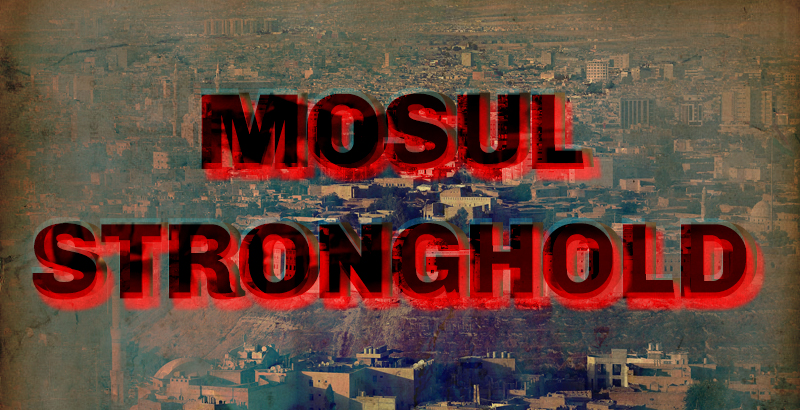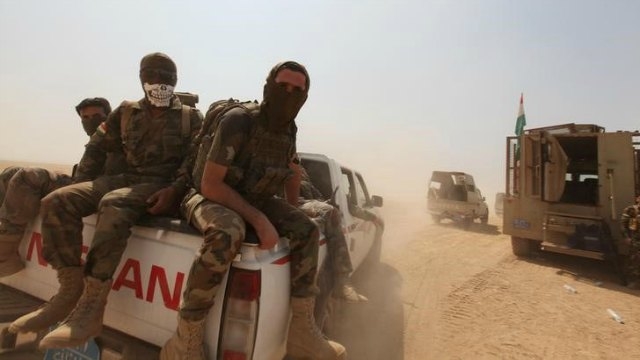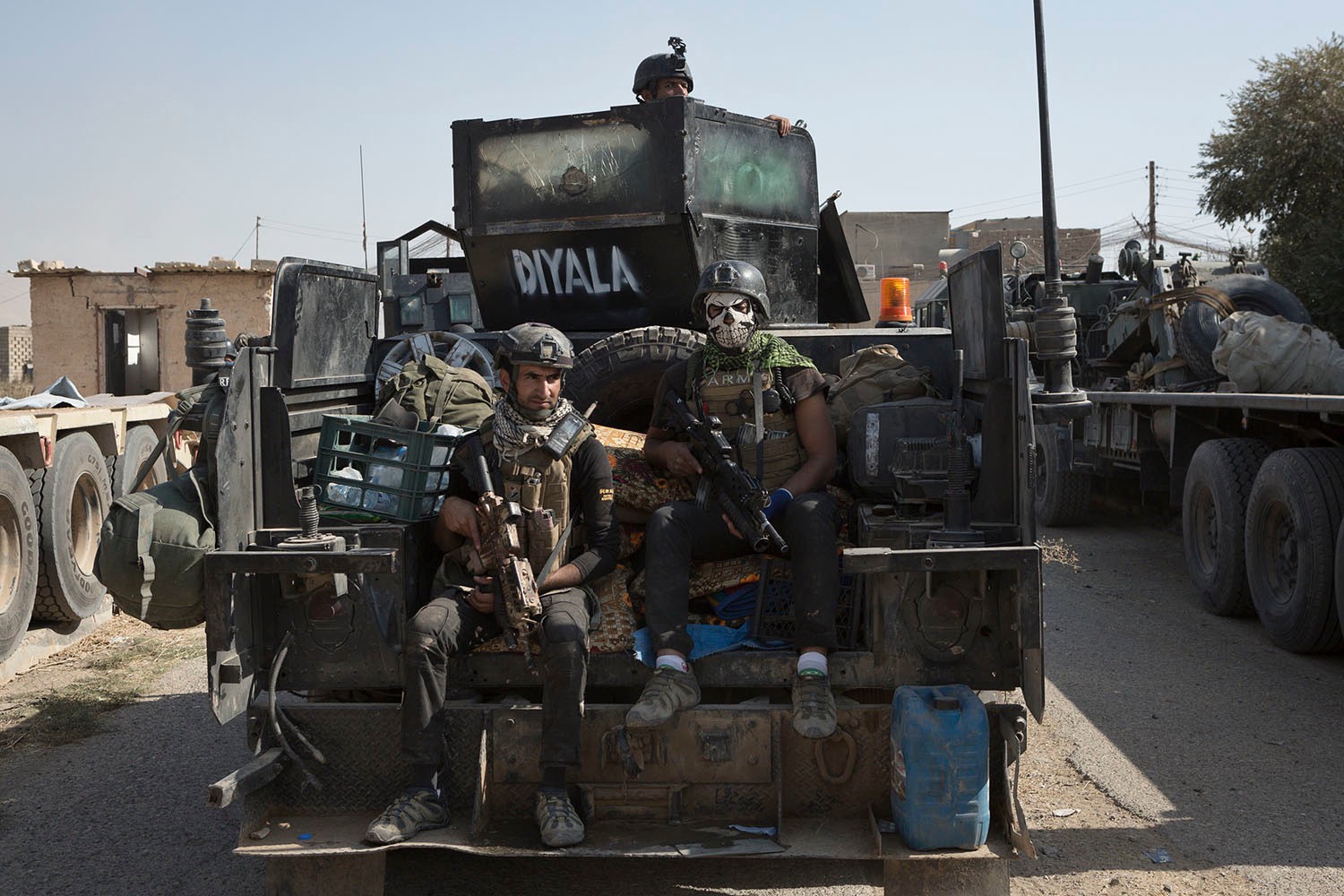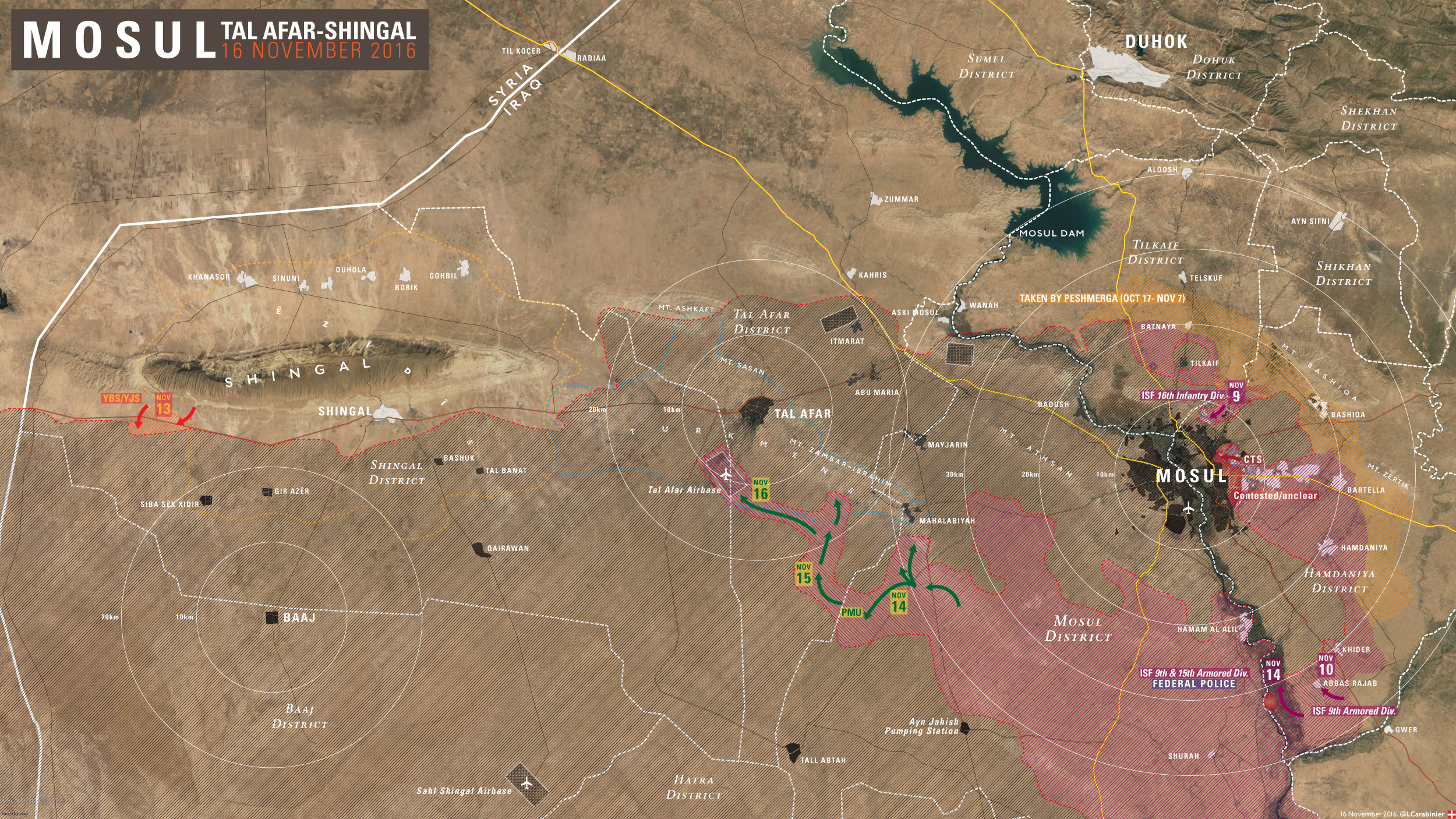
According to the President of Iraqi Kurdistan Masoud Barzani, the anti-IS coalition forces will need 3 months to get Mosul under their control.
The military situation in and around the city of Mosul is unfolding quite differently than that of the other major militant stronghold – Aleppo (READ MORE: THE STRONGHOLD OF ALEPPO).
Mosul is the second largest city in Iraq, after Baghdad. It is a city of 1.5 million people (according to UN estimates). It is a city where Sunni Arabs, Shia Arabs, Kurds, Yezidis, Armenians, Assyrians, Turkmens, and even some followers of Christianity have coexisted for a very long time. Mosul is also the informal political and economic capital of Sunni Iraq. An ethnically multifaceted city, it has the highest percentage of Christians of all the Iraqi cities.
Economically, Mosul is a sufficiently large center of oil production. Before the Russian operation to target and destroy the oil caravans that had followed the “northern route”(Iraq-Syria-Turkey), ISIL received up to $ 50 million per month from this trade. Mosul is also a transportation hub. Three major highways pass through Mosul: the Baghdad (№1) – Mosul – Syrian border – Aleppo (M4), the Baghdad (№2) – Mosul – Turkish border, and the Mosul – Kirkuk (№80). The city has been a major transportation hub since the middle of the 19th century. The branch of the so-called Baghdad railway also passes through the city. The city is located on the largest river in the Middle East, the Tigris River. The largest hydroelectric power station in Iraq is situated on this river (60 kilometers from the city).
Factors which have played a role in the downfall of Mosul
The Sunni factor
At the decades of Saddam Hussein’s Iraq, the city and its suburbs were the place of residence of retired Iraqi servicemen. Generally, these were Sunni Arabs. Iraq called Mosul the “City of One Million Soldiers”. According to varying estimates, more than 7,000 retired officers of Saddam’s army and more than 100,000 soldiers dismissed from service were living in the city at the time that Mosul was overrun and occupied by ISIL. After the U.S. invasion in 2003, the American command decided not to conduct large-scale fighting against all forces opposed to the invasion and occupation, but instead, to squeeze them out from Baghdad and its suburbs. From the moment of the end of operation Vigilant Resolve and Phantom Fury, Al-Qaeda supporters and the armed groups of Sunni Arabs began to crowd into Mosul. In 2011, the prime minister Nouri al-Maliki (Shia Arab), appointed Lieutenant General Mahdi Gharawi to the post of Chief of Police of Mosul. Lieutenant General Mahdi Gharawi was a Shia Muslim. Sunni Arabs considered him a criminal, who used the American invasion of the country as a pretext to squeeze money out of local businesses and citizens. Many murders of innocent citizens were attributed to his corrupt, strong-arm measures. According to the governor of the province and many residents, Mahdi Gharawi spoiled the good historical relations with Sunni and Shia citizens in the city with the national government on the eve of fall of the city to ISIL. It was a factor which encouraged the rise of the underground resistance group concerned around ISIL.
The Kurdish factor
With defeat of the Iraqi army in 2003, the Kurdish paramilitary forces have taken under their control the cities of Kirkuk and Mosul, which to a varying degree are also inhabited by Kurds. They launched a large-scale operation, expelling the Arab settlers. The Kurds did not have any autonomy under the rule of Saddam Hussein. This was a continuous source of unrest and protest between the Kurds and Iraqi administrations. In 2008, Nouri al-Maliki began to take measures to ensure control over Mosul. Understanding that the Kurds would be disloyal to the government in Baghdad, he dismissed all Kurdish officers from the two army divisions deployed in Mosul and appointed his own people to take their place.

Kurdish Peshmerga forces ride on military vehicles on the southeast of Mosul, Iraq, August 14, 2016. (Reuters)
It is also necessary to state that a role in delivery of the city to Islamic State terrorists was played by the conflict surrounding the profits to be made from oil. In 2013-2014 the contradictions between Baghdad and Erbil (the capital of the Iraqi Kurdistan) concerning questions of income distribution from the operation of oil fields in the north of the country and partnership with foreign oil companies, sharply amplified. According to the American newspaper Wall Street Journal, for 2013 oil inventories in Iraqi Kurdistan were estimated at 45 billion dollars, and for all of Iraqi, at 120 billion dollars. According to the constitution of Iraq, all inventories of energy resources belong to the state, and the Iraqi Kurdistan gets only 17% of them. Nevertheless, autonomy management repeatedly declared that it gets less. The Iraqi Kurdistan, providing to the foreign companies more advantageous conditions of cooperation on the basis of production sharing agreements, became a more attractive partner in comparison to the other oil-extracting regions of Iraq. The Iraqi government signed only service contracts. According to these contracts, the foreign companies work as contractors, earning the money for investigation and operation of fields, and also the guaranteed deliveries of the stipulated oil amount at market prices. In January, 2014 attempts by the prime minister of Iraq, Nouri al-Maliki, to reign in the independent oil dealings of Iraqi Kurdistan, motivated an agreement between Iraqi Kurdistan and Turkey on oil export through the Mediterranean ports of Turkey, without sanction of the Iraqi government. The government of the Iraqi Kurdistan actually sold oil at the price 50% from market price. The management of ISIL in turn sold oil from the occupied Iraqi and Kurdish areas at the price 30% from market price. Neither the Iraqi government, nor the Kurdish government could suffer such frank robbery.
It is also important to note that in 2014, when the fighting with Islamic State terrorists for control of Mosul and other key cities in the region were already going, Masoud Barzani suggested to Nouri al-Maliki that the Kurds and the central government work together to defend Mosul, having already marked out the necessary number of divisions of peshmerga. The prime minister refused. Most likely, Nouri al-Maliki was afraid that after the resolution of the problem with Islamic State terrorists, the Kurdish divisions would not leave the areas occupied by them.
The condition of Iraqi forces on the eve of the city falling
On the eve of the storming of one of the sites on the front line in Mosul there was the sixth brigade of the third division of armed forces of Iraq. According to the official lists there were supposed to be 2500 people in the unit, yet in reality there were only 500 troops in the ranks. It has been widely established that many commanders received monetary payments from their subordinates in exchange for being allowed to go home. Thus, from 25000 troops charged with protecting the city there were at best 10000 troops, many without weapons and ammunition. All heavy weapons had been involved in an army operation in the Province of Anbar. According to Mahdi Gharawi, the chief of staff of the armed forces of Iraq and the commander-in-chief of ground forces had to provide additional forces to defend the city, but these troops were stationed far from the area of operations. One way or another, soldiers have begun mass desertion, and 2000 Islamic State terrorists in six days (on June 4-10, 2014) had succeeded in taking the city under their control. It is obvious that such a number of Islamic State terrorists couldn’t take Mosul on their own without the aid of Sunni underground resistance groups and supporters of Al-Qaeda. According to eyewitnesses, there were a great number of inhabitants welcoming the fighters on city streets. Conflicts on ethnic and religious grounds, corruption and intrigues in the highest military and government offices of the country led to the fact that the city fell.

Iraqi Army Golden Brigade soldiers travel through Bartella on the back of an armored Humvee. Matt Cetti-Roberts photo
So, on October 16, 2016, a decisive attempt to storm Mosul was once again declared. It should be noted that for ISIL, Mosul is their last stronghold in Iraq and a key source of income from oil sales. For the governments of Iraq and the Iraqi Kurdistan, it is a question of control over the region in which, first of all, their financial interests depend. For their western colleagues, the operation represents a important PR campaign and a source of political dividends.
The situation around Mosul
One of the leaders of a Shia armed group of Iraq, Hadi Al-Amery, declared that Mosul on degree of duration and intensity of fighting, can become one more Aleppo. This statement is refuted by the following arguments:
Structure of coalition forces
- Iraqi security forces (54000 soldiers)
- Peshmerga (up to 40000 soldiers)
- Sunni Militia loyal to the government (to 9000 people)
- Shia militias, units of Turkmens, Yazidi and Christians that operate as a part of the Popular Mobilization Units (PMU), also known as the Popular Mobilization Forces (PMF) (up to 5000 people)
- Approximately 5000 American servicemen
- More than 130 artillery weapon systems, several hundred of armored vehicles, and also about 90 warplanes, helicopters and fighting unmanned aerial vehicles.
Such a patchwork coalition inevitably creates additional problems during operations, firstly concerning the organization of troops’ cooperation and coordination. About 9000 Islamic State terrorists full of determination not to hand over the city, equipped with many vehicle bound improvised explosive devises (VBIED) and chemical weapons stand in opposition to them. The absolute advantage in numbers, equipment and professionalism definitely favor of the coalition. In Aleppo, the Syrian government army, with assistance of the Iranian Islamic Revolutionary Guards Corps and groups of volunteers, stand against an armed opposition roughly equal in number.
Humanitarian situation
In Aleppo the government of the Syrian Arab Republic (SAR) has organized 6 humanitarian corridors to facilitate the exit of civilians, as well as the armed opposition. Personnel of humanitarian organizations are ready to help all persons who need it. Over Aleppo, leaflets with the indication of routes of humanitarian corridors have been dropped. In Mosul humanitarian corridors haven’t been organized. Leaflets with an appeal to organize armed resistance to Islamic State terrorists have been dropped, but weapons have not been dropped for some reason. On the UN’s initiative, 5 camps for 120000 people are ready to be organized. It is obviously not enough for the estimated 1.5 million people that reside in the city. The U.S. President Barack Obama, has declared that humanitarian aid will be provided only after the city’s liberation. Meanwhile, the situation in the city can be described as catastrophic. There is no organized transportation of food and fuel, power supply is absent, and medical care isn’t provided.

Fig.2 Residents of Mosul are in line for food

Fig.3 Children of Mosul play on ruins
Unburied killed civilians create the danger of the outbreak of infectious diseases. ISIL have stocks of chlorine, mustard gas and ammonia at their disposal. A WMD attack in the city will cause mass victims among civilians which have no gas masks or protective NBC clothing. American specialists estimate that during the construction of the dam of the Mosul hydroelectric power station, engineering mistakes were made and its technical condition causes concerns. Now it formally is in the zone of responsibility of the Kurdish armed groups, but nobody can give guarantees that Islamic State terrorists won’t make an attempt to conduct a terrorist attack against the dam. If there is an accident or terrorist attack on a dam, Mosul will be covered by a wave of water 65 feet high, and Baghdad will be covered by a wave 15 feet high. Further comment on the catastrophic results of such a disaster are needless.
Tactical techniques of the opposing sides
Features of conducting combat operations by ISIL
There are former officers of Saddam’s army among ISIL fighters who are natives of Mosul and who perfectly know the city and its communications. This fact makes storming of the city almost an impracticable task. Among the enlisted personnel of ISIL there is a significant number of fighters who have experience of conducting urban warfare in Afghanistan, Chechnya, Libya, and Syria. These people know all about warfare in an urban environment. The western media draw the Islamic State terrorist as wild, cruel and stupid. Such light-mindedness in the enemy’s assessment already leads to casualties. In less than a month of combat in the suburbs of Mosul, in areas with a civilian population loyal to the government coalition, there have already been more than 3000 people killed and wounded, 22 tanks, and more than 120 lightly armored vehicles destroyed. Islamic State terrorists and their command are not yesterday’s shepherds and peasants who took weapons in hand only yesterday. They are people for whom the war became a profession. It should also not be dismissed that Islamic State terrorists are more motivated in comparison with the troops aligned against them. First of all, there is a religious component. Secondly, for the former Iraqi officers who came over to ISIL, it is an opportunity to get revenge on the USA for the war which has torn Iraq to pieces since 2003. Therefore, defense of the city by ISIL is conducted in due regard for the tenants of military science. The city has been under the control of ISIL for a long time and is respectively prepared in regard to the engineering of defensive positions. As the Iraqi military has repeatedly attempted to storm Mosul in the past, IS commanders have surely carried out measures to strengthen the most vulnerable sites of defense. In one of the suburbs of Mosul international coalition forces captured the self-made mortars shooting gas cylinders. It helps terrorists to built underground tunnels for the hidden movement between buildings and even between the different suburbs of Mosul. Tactical methods of ISIL fighters are characterized by quick maneuvering in a square with use of these prepared avenues of approach, ambushes and traps. Grenade launchers (RPG-7, RPG-18, RPG-22) are used in large quantities and mortars are more rare in the conditions of fighting in the city. In the areas where the enemy is most likely to appear, mines traps and land mines are already prepared. On highways, ISIL uses VBIED and long-range artillery in large quantities. The nature of these attacks demoralizes the opponent, and reduces the rate of his offensive. They have also conscripted for military service 15-18 year old teenagers as shahids who have insufficient warfare experience. As camouflage security from air strikes, and also with the purpose to complicate overcoming defense of the city, holes and trenches with oil products are set on fire. From the beginning of the latest Mosul operation, IS conducted a counterattack near the city of Kirkuk, in an effort to bleed resources away from the coalition’s efforts against Mosul. Similar attacks were made in 2015 and 2016 to distract attention away from the city. IS uses long-range artillery, including shells filled with mustard gas and chlorine in areas which are attacked by peshmerga units. On October 20, 2016 Islamic State terrorists arranged an act of sabotage in Al-Mishraq, at a sulfur plant. This action resulted in the mass poisoning of civilians. ISIL is also using civilians as human shields to prevent air strikes.
Features of conducting combat operations by the coalition
The general concept of the operation is as follows: Units of peshmerga conduct an attack from the North and the East. The ISF, with the assistance of Shiite militia conduct an attack from the South. The armed groups of Kurds are tasked with blockading the city. The ISF takes Mosul under control. In a separate development, the Americans and their Iraqi allies moved to isolate the route to the Syrian border to prevent reinforcements of Islamic State terrorists from Syria to Iraq. Only a month after the start of the operation, the coalition command sent Shia militia and Hezbollah units [They operate as a part of the PMU/PMF] to block the highway to the west of the city. This is an amazing fact! The U.S. is actively utilizing an organization internationally recognized (most ironically by the U.S. itself) as a terrorist group in its conflict against other terrorists.

Fig. 4 IFV on the road to Mosul
Separately, a few words about the US forces involved. There are about 5000 American soldiers deployed near Mosul. Official sources have specified that there are about 200 soldiers in the combat zone, generally it is USSOCOM personnel and forward air observers. How the remaining 4800 soldiers are employed has yet to be specified. As far as information is available, 1,700 soldiers of the 2nd brigade of the 101st airborne division are placed at Qayyarah air base, approximately 60 km from Mosul. Units of the 18th field artillery brigade are deployed at the same location to provide fire support to the American paratroopers. Besides that, the USMC battalion (Task Force Spartan) also acts in this area. Units of the 82nd airborne division shall replace their colleagues from the 101st division. They completed a two-month course in urban warfare, and also warfare in a chemical weapons environment. An exact time frame of rotating the airborne units has not been announced. This means that the Pentagon may be keeping the paratroopers of the 101st airborne division in reserve.
It appears that the pre-election project of the Democratic Party of the USA, under the title “Quick Capture of Mosul” has, seemingly, failed together with Hillary Clinton’s presidential campaign. Now, the tactics of the USA administration have changed. This may mean that Donald Trump gets dragged into a quagmire of a war. That being stated, high-ranking Pentagon officials no longer believe that the Iraqi military is capable of taking Mosul, and have been preparing a plan with greater participation of the US Armed Forces. Troops of the USA have already sustained losses: 16 killed and 27 wounded in the first 3 weeks of the offensive. The majority of these US casualties were due to artillery fire, the detonation of mines and friendly fire from coalition aircraft.

Fig.6 Coalition artillery deliver firepower against ISIL
The coalition has an overwhelming advantage in forces and means of a technical reconnaissance, aviation and artillery support, mobile means, without speaking about material logistics of parts in the battlefield. According to the statement of the official representative of the U.S. Department of State John Kirby, in Mosul there are no civilians, there are only terrorists. This means that the coalition exposes the city to attacks from both air and land based fires for a quick victory, regardless of civilian casualties. It is quite possible that there will be enough camps organized by the UN for all of the survivors. It is remarkable that the offensive is conducted on the east and southeast districts of the city. These areas of predominantly the residence of Kurds and the mixed Arab population. This means that resistance of Islamic State terrorists in these areas should be the weakest. It is logical then to conclude that the American military personnel, as the most prepared and capable, will perhaps be involved in fighting in the western part of the city.
Taking all the aforementioned into consideration, it should be noted that the situation around Mosul is absolutely unique. At first sight, the coalition does not appear to have encountered too much difficulty in efforts to block the city and to take it under control. They have sufficient personnel, weapons, intelligence data and support from air. There is one more important fact to mention. The highway to Syria wasn’t controlled for nearly a month; the city was not completely surrounded. This confirms the theory that operational command specially left Islamic State terrorists a corridor of escape in case they might want to leave the city. Strengthening of the ISIL groups located in Syria by the fighters who arrived from Mosul will in addition, complicate the already difficult situation facing the Syrian government. There is information that these forces may relocate to Syria to participate in warfare near Palmyra and Deir-Ezzor. Leaders of Kurdistan declared that peshmerga will participate in actions only to encircle and blockade the city. Turkish officials declared that the Turkish Armed forces will take part in the operation to liberate Mosul. The announcement caused a sharp negative reaction, from both the Iraq government and leaders of the Kurds. The fact that the ISF and the Iraqi Kurdish units are cooperating in a concerted effort is very interesting. Baghdad high officials do not want to let Kurdish forces into Mosul — they are afraid that they will annex it to the autonomous Kurdistan, as was the case with oil-rich Kirkuk. The leaders of Iraq and Iraqi Kurdistan would never have agreed to participate in this operation together if it had not been for the high level mediation of the U.S. State Department. This most likely points to pre-negotiated arrangements regarding the separation of spheres of influence in the country. Nobody speaks about this in the mass media and what these arrangements might entail. We will see after the capture of the city. For now, all of these disagreements, negotiations, the awful humanitarian situation and the delays in the effort to liberate the city, do nothing to improve the situation of countless civilians who are slaughtered, both at the hands of the terrorists, and the coalition.









kurdish amok has started. https://www.youtube.com/watch?v=2VCTWs6C4ck
https://www.almasdarnews.com/article/barzani-peshmerga-wont-withdraw-areas-liberated-isis/